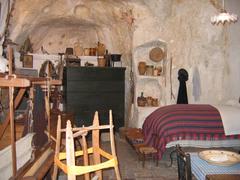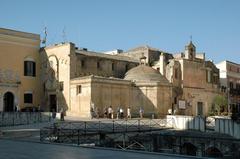Matera Cathedral: Visiting Hours, Tickets, and Historical Significance
Date: 15/06/2025
Introduction
Nestled atop Civita Hill in Matera, Italy, the Matera Cathedral—officially the Cathedral of Santa Maria della Bruna and Sant’Eustachio—is one of the city’s most iconic landmarks. Built between 1203 and 1270, this cathedral is a masterpiece of Apulian Romanesque architecture, with Byzantine and Baroque artistic influences that reflect Matera’s rich cultural evolution (Matera Cathedral: History, Architecture, and Visitor Guide; Visiting the Cathedral Basilica of the Assumption of Mary in Matera). Its prominent position between the UNESCO-listed Sassi districts offers sweeping panoramic views of Matera’s unique landscape of ancient cave dwellings and winding alleys.
The cathedral’s imposing exterior, highlighted by a sixteen-ray rose window and 52-meter bell tower, gives way to an interior adorned with gilded altars, elaborate stuccoes, and significant religious artworks (Matera Cathedral Visiting Hours, Tickets & Complete Visitor Guide). Beyond its architectural grandeur, the cathedral remains the vibrant heart of Matera’s spiritual and cultural life, especially during the annual Festa della Bruna on July 2.
This comprehensive guide covers everything you need to know about visiting Matera Cathedral—its history, architectural highlights, visiting hours, ticketing policies, accessibility, cultural significance, and nearby attractions. Whether you are a history buff, architecture lover, or cultural traveler, Matera Cathedral offers a unique window into the soul of the city (Matera Cathedral: Architectural Marvel, Visiting Hours, Tickets, and Visitor Guide).
Historical Background and Construction
The Matera Cathedral was commissioned in 1203 after Pope Innocent III elevated Matera’s episcopal seat to an archdiocese (Wikipedia; Spotting History). Its foundation marked a significant urban redevelopment of Matera’s Civita district, replacing earlier religious structures such as the Benedictine monastery of Sant’Eustachio and the ancient Church of Saint Eustace (Hotel Belvedere; Materasassiemurgia). The cathedral’s construction was completed in 1270, as indicated by an inscription near its bell tower (Italyscapes).
Over time, the cathedral’s dedication evolved, reflecting Matera’s shifting religious and civic identity. Initially dedicated to Santa Maria di Matera, by the late 14th century it was known as Santa Maria della Bruna, Matera’s patron saint, and later also included Saint Eustace as a co-patron (Spotting History; Materasassiemurgia).
Architectural Features
Exterior
Matera Cathedral is a prime example of Apulian Romanesque architecture, constructed from local tuff stone. Its façade is dominated by a sixteen-ray rose window and a central portal flanked by statues of Saints Peter and Paul. The left-side bell tower, originally lower, was raised to 52 meters and capped with a spire (Hotel Belvedere; Italyscapes; Sassi di Matera).
Other notable features include the Porta dei Leoni with its carved lions, Abraham’s Door on the south side, and the emblem of King Ferdinand I of Aragon, attesting to Matera’s historical significance (Italy Magazine).
Interior
The cathedral’s Latin cross plan features a higher central nave and two side aisles, separated by ten intricately carved columns—remnants of the original medieval structure (SassiWeb). The interior underwent significant Baroque transformations between the 17th and 18th centuries, including gilded stuccoes, opulent altars, and a wooden false ceiling by Giuseppe Porta.
Key artistic highlights include:
- The 13th-century Madonna della Bruna fresco, embedded in a Baroque altar and venerated during the annual festival (Divento).
- The Cappella del Presepe, with a 14th-century stone nativity scene by Altobello Persio.
- The 19th-century canvases by Giovanni Battista Santoro, and additional masterpieces by Giovanni Donato Oppido and Domizio Persio (Hotel Belvedere).
- The 18th-century pulpit with papier-mâché decorations and a mid-20th-century pipe organ.
Restoration work completed in 2016 preserved both the Romanesque exteriors and the Baroque interiors—revealing hidden frescoes and stabilizing the structure (Italy Magazine; Sassi di Matera).
Visiting Matera Cathedral: Hours, Tickets, and Access
Opening Hours
- General schedule: Daily from 9:00 AM to 7:00 PM.
- Note: Hours may vary during religious festivals and special events. Always check the official Matera tourism website or on-site notices for the latest updates.
Tickets and Admission
- Cathedral entry: Free for individual visitors.
- Guided tours and exhibitions: May require paid tickets, available at the entrance or through authorized tourism platforms.
Accessibility
- Mobility: The cathedral offers partial accessibility for visitors with reduced mobility; some areas may present challenges due to the medieval structure.
- Assistance: Available on request.
Facilities and Practical Advice
- Footwear: Wear comfortable shoes for the uneven, cobbled streets.
- Facilities: Public restrooms and cafés are nearby.
- Parking: Limited in the historic center; use designated parking outside the Sassi and walk or take local shuttle services (Megan Starr).
Special Events and Cultural Significance
Festa della Bruna
The cathedral is the focal point of the annual Festa della Bruna on July 2, Matera’s most significant religious and cultural event. The festival features elaborate religious processions, fireworks, and traditional rituals, attracting thousands of locals and visitors (Exploristica365).
Religious and Artistic Heritage
Matera Cathedral remains the principal Catholic place of worship in the city and the mother church of the Archdiocese of Matera-Irsina. Its layered artistic styles chronicle Matera’s journey from medieval roots through Baroque splendor and into the present, reflecting the city’s resilience and evolving identity.
Nearby Attractions
- Sassi di Matera: The ancient cave dwellings, a UNESCO World Heritage Site, are just steps from the cathedral.
- Casa Noha: A multimedia museum showcasing Matera’s history (Exploristica365).
- Rock-hewn churches: Including San Pietro Barisano and Santa Maria di Idris, exemplifying Matera’s unique rupestrian heritage (Along Dusty Roads).
- Museum of Medieval and Modern Art in Palazzo Lanfranchi: Exhibits artworks from the cathedral and other Matera treasures.
Photography and Visitor Etiquette
- Photography: Permitted in most areas but restricted during religious services. Flash and tripods may be prohibited.
- Dress code: Modest attire is required—shoulders and knees should be covered.
- Behavior: Maintain silence and respect during services.
Sustainability and Responsible Tourism
To help preserve Matera Cathedral and its surroundings, visitors should dispose of litter responsibly and follow guidelines for safeguarding cultural heritage. Practicing sustainable tourism ensures these treasures endure for future generations (Exploristica365).
Frequently Asked Questions (FAQ)
Q: What are the Matera Cathedral visiting hours?
A: Typically open daily from 9:00 AM to 7:00 PM, but always verify before your visit.
Q: Is there an admission fee?
A: Entry is free; some special exhibitions or guided tours may require a ticket.
Q: Is Matera Cathedral accessible for those with mobility challenges?
A: Accessibility is partial due to historic architecture. Contact local services for assistance.
Q: Can I take photos inside?
A: Yes, but avoid flash and tripods, and respect worshippers during services.
Q: Are guided tours available?
A: Yes, and they’re highly recommended for deeper insights into the cathedral’s history and art.
Visuals and Media
[Insert high-quality images of the cathedral’s exterior, rose window, bell tower, interior artworks, and the Festa della Bruna celebrations, with SEO-optimized alt tags such as “Matera Cathedral rose window” or “Interior of Matera Cathedral featuring Baroque stuccoes.“]
[Embed an interactive map highlighting the cathedral’s location and links to virtual tours if available.]
Internal and External Links
For more insights into Matera and its attractions, visit our related articles:
- Exploring the Sassi of Matera
- Top Historical Sites in Basilicata
- Italian Romanesque Architecture Highlights
Official and authoritative sources:
Summary and Recommendations
Matera Cathedral is a testament to the city’s enduring historical and cultural legacy. Its Apulian Romanesque architecture, enriched by Byzantine and Baroque elements, captures Matera’s medieval origins and evolving traditions. The cathedral’s elevated position offers breathtaking views, while its interior treasures and annual festivals connect visitors to the living heart of Matera (Matera Cathedral: History, Architecture, and Visitor Guide; Matera Cathedral Visiting Hours, Tickets & Complete Visitor Guide).
Whether you’re admiring the rose window, exploring the Sassi, or joining the Festa della Bruna, a visit to Matera Cathedral is an unforgettable experience. Pair your visit with guided tours and nearby attractions for a deeper appreciation of the city’s heritage.
For more travel tips and updates, download the Audiala app, explore our related posts, and follow us on social media. Start your Matera adventure today!
References
- Matera Cathedral: History, Architecture, and Visitor Guide to a Matera Historical Site, 2025, Spotting History
- Visiting the Cathedral Basilica of the Assumption of Mary in Matera: Hours, Tickets, and Cultural Insights, 2025, Catholic Shrine Basilica
- Matera Cathedral: Architectural Marvel, Visiting Hours, Tickets, and Visitor Guide, 2025, Italy Magazine
- Matera Cathedral Visiting Hours, Tickets & Complete Visitor Guide to Matera Historical Sites, 2025, Along Dusty Roads


